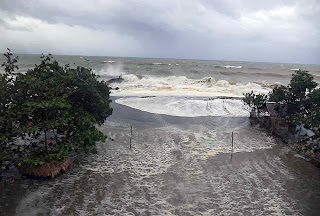
photo courtesy of: gmanetwork.com
Last November 8, 2013, the Philippine Islands was badly devastated by one of the strongest typhoon in Earth’s history. Carrying sustained winds of up to 314 kilometers/hour, Yolanda(Haiyan) killed 3,000 people(and counting as per time of writing) and destroyed almost 10 billion pesos worth of properties. It was really this frightening that it displaced almost 750,000 people out of their home towns. Storm surges also occurred displacing huge boats from the water to the land. We were very thankful that foreign aids from different countries are pouring in and out to support the Philippines. (This article is brought to you by: rayomarine.com- a top company who’s into catamaran for sale in the Philippines.)
Not known to everyone, the Philippine government already prepared for this Super Typhoon soon enough before it hits the land. The local government, evacuated the residents of the town mostly women and children. They also informed the local residents of storm surges that can rise up to 20 feet every hour but no one was familiar with the term which caught residents unprepared. With an average of 20 typhoons hitting the country, the Philippines should expect a typhoon with the same magnitude as Haiyan. Preparing for the Storm
1. Be updated and know the signs.
Before the storm approaches, weather institutions provide their forecast about the incoming storm. They will provide details on the path it will be taking, the magnitude of the storm whether it will bring storm surges or not and when it will leave. If storm surges will be happening it is good to know how high the storm surge will be and how far is the reach of the storm surge from the sea.Aside from government institutions, animals are also good determinants if there are changes in your surroundings. Animals have sixth sense and changes in their attitudes are observed in times of troubles.
2.Prepare for the worst.
After knowing the facts, prepare canned goods, water,radio and dry, clean clothes which are light enough to be carried through your back pack. Also bring with you, important documents. Prepare your house and household members and inform them what to bring and what to leave. If you have a boat, dock your boat in another place where the storm would not be taking place.
3.Coordinate with the authorities.
Government authorities provide evacuation centers for the typhoon victims. Better coordinate with them and know their plans about this storm.
4.Evacuate
Assess your location, if you are on a low lying area, you should find a sturdy, higher place where it won’t be reached by the storm surge.Evacuation center should also be higher than the said storm surges. Be sure to evacuate as early as possible.
5.Check if the storm is over.
When the storm is over, check if the surroundings is safe. Use your radio with and be updated with the current situation in your area.
With proper preparation, your survival rate will have higher chances.
No comments:
Post a Comment